Thursday, August 31, 2006
Thursday, August 31 Class, The Irony of Rap Songs
August 30 Sam off to College, Beekeeping, Fasting
Tuesday, August 29, 2006
Tuesday, August 29, 2006 Sick, UCSB's Rankings

I spent today sick in bed. I unpacked my things, wrote in my journal, and did laundry. A bunch of people are working at NGOs, which seem only slightly fulfilling. Brianna is writing a textbook on environmental law, the girls are working 3 days a week for a women’s rights group, Tara and Snehal are working in a school, and Christina is teaching English (it might help if she actually spoke English, though). I was thinking about symbols exclusively found in
 cart charged 5 Rs per banana, which is more than you’d pay in the
cart charged 5 Rs per banana, which is more than you’d pay in the 
Monday, August 28 Taj Mahal, Agra Fort, Akbar's Tomb in Sikandara

I woke up at 5 am, and Nikhil and I took a taxi to the Taj Mahal to see it when it opened at 6 for the sunrise. We were amongst a handful of tourists there, which made for great pictures. It was totally peaceful and serene, definitely worth the sacrifice of 750 Rs and sleep. Instead of yellow like last night, the marble façade of the Taj was now painted pink in the sunrise. The tomb was so quiet in the morning, and Hindus bathed in t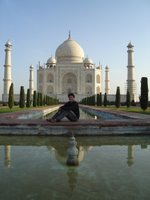 he sacred ghats on the banks of the Yamuna in back of the tomb. I hired a photographer to take my photo in a series of picturesque spots. We took a bike rickshaw back to the hotel, and had breakfast before leaving for Agra Fort, another World Heritage site. The fort was surrounded by 2.5 km of red sandstone ramparts to deter invaders. A crocodile-filled moat was surrounded by a high wall with holes for archers, surrounded by a dry moat filled with lions and tigers. In a day you could be breakfast for crocodiles, killed for lunch by guns, and supper for man-eating tigers. The doors were built along curving pathways, designed to deter elephants who could not make fast turns. Construction began in the 16th century. Inside the walls were a series of beautiful archways, thrones, mosques, prisons, and houses for the wives of the emperor. A colonnaded hall enclosed Akbar’s throne, from which the view of all columns were unobstructed. The emperor had 300 concubines, one for every day of the year (because Muslims have Fridays off). The concubines’ residences were guarded by eunuchs, who were physically stronger than women but didn’t have the desi
he sacred ghats on the banks of the Yamuna in back of the tomb. I hired a photographer to take my photo in a series of picturesque spots. We took a bike rickshaw back to the hotel, and had breakfast before leaving for Agra Fort, another World Heritage site. The fort was surrounded by 2.5 km of red sandstone ramparts to deter invaders. A crocodile-filled moat was surrounded by a high wall with holes for archers, surrounded by a dry moat filled with lions and tigers. In a day you could be breakfast for crocodiles, killed for lunch by guns, and supper for man-eating tigers. The doors were built along curving pathways, designed to deter elephants who could not make fast turns. Construction began in the 16th century. Inside the walls were a series of beautiful archways, thrones, mosques, prisons, and houses for the wives of the emperor. A colonnaded hall enclosed Akbar’s throne, from which the view of all columns were unobstructed. The emperor had 300 concubines, one for every day of the year (because Muslims have Fridays off). The concubines’ residences were guarded by eunuchs, who were physically stronger than women but didn’t have the desi res of men. Eunuchs gained power because no one could oppose them. If you refuse to give them money at births or weddings, they will strip their clothes, embarrassing you in front of your entire family. They could rule
res of men. Eunuchs gained power because no one could oppose them. If you refuse to give them money at births or weddings, they will strip their clothes, embarrassing you in front of your entire family. They could rule  ter telephone, which was hilarious and utterly impossible. I stocked up on lunch at the Five Star. They had beef kebabs, with which I filled several plates. On the way back to
ter telephone, which was hilarious and utterly impossible. I stocked up on lunch at the Five Star. They had beef kebabs, with which I filled several plates. On the way back to  into four quadrants. There were wide avenues leading from ornate gateways to the tomb. I went to use the bathroom, but they tried charging me, so instead I walked a couple feet and went in the bushes. While I was peeing, hawkers continued to try and sell me jewelry. The ride back was long and boring. We stopped at a rest stop that charged 30 Rs for chai, while the shack 10 feet away outside probably charged 3. The whole drive I felt sick to my stomach. I suppose it’s the result of eating five plates of beef at lunch.
into four quadrants. There were wide avenues leading from ornate gateways to the tomb. I went to use the bathroom, but they tried charging me, so instead I walked a couple feet and went in the bushes. While I was peeing, hawkers continued to try and sell me jewelry. The ride back was long and boring. We stopped at a rest stop that charged 30 Rs for chai, while the shack 10 feet away outside probably charged 3. The whole drive I felt sick to my stomach. I suppose it’s the result of eating five plates of beef at lunch.
Sunday, August 27 Fatehpur Sikri, TAJ MAHAL
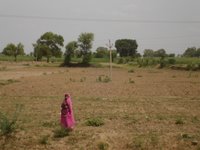 Mughal
Mughal  ywhere, selling postcards, jewelry, and marble handicrafts. We got into our hotel in
ywhere, selling postcards, jewelry, and marble handicrafts. We got into our hotel in 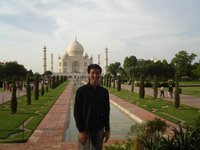 mausoleum built in the 17th century by Shah Jahan as a monument to his wife who died in childbirth. It is situated on the south bank of the
mausoleum built in the 17th century by Shah Jahan as a monument to his wife who died in childbirth. It is situated on the south bank of the 
Saturday, August 26 Amber Fort, Shopping in Jaipur

Vijay was annoyed because everyone was late this morning. He complained, “I need a stick to beat everyone who’s late”, and then when Nikhil asked for the fans to be turned on, he joked, “Nikhil, you are so difficult”. We drove to Amber Fort nearby. From there, we rode elephants up the steep hill to the 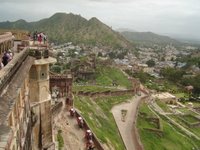 e original capital, and the fort was ornately decorated with gold, mirrors, and intricate carving. The fort housed swimming pools, ancient air-conditioning systems, gardens, and fountains. The fort overlooks the city of
e original capital, and the fort was ornately decorated with gold, mirrors, and intricate carving. The fort housed swimming pools, ancient air-conditioning systems, gardens, and fountains. The fort overlooks the city of  ials and astronomical tools used to calculate seasons, time, and the stars. The main sundial was so big that it was marked with ticks for minutes, and you could see the shadow moving across it. It was also completely accurate. During lunch I was embarrassed when Katie asked “What is wrong with this country? Why can’t they just have beef instead of mutton?” Why don’t we just cut up Jesus Christ and put it on a skewer and eat it? After lunch, I headed out to the
ials and astronomical tools used to calculate seasons, time, and the stars. The main sundial was so big that it was marked with ticks for minutes, and you could see the shadow moving across it. It was also completely accurate. During lunch I was embarrassed when Katie asked “What is wrong with this country? Why can’t they just have beef instead of mutton?” Why don’t we just cut up Jesus Christ and put it on a skewer and eat it? After lunch, I headed out to the  er of camel leather, pointed-toe shoes. A tout came up to me and I got him to give me some puppets for 80 Rs. I took a bicycle rickshaw to Hawa Mahal, or
er of camel leather, pointed-toe shoes. A tout came up to me and I got him to give me some puppets for 80 Rs. I took a bicycle rickshaw to Hawa Mahal, or 
Friday, August 25 Rajasthan, Jaipur, City Palace, Five-Star Hotel
 Vijay calling up Indian Railways, “Hi, can I make a reservation for 40 Americans please?” On the way out of
Vijay calling up Indian Railways, “Hi, can I make a reservation for 40 Americans please?” On the way out of  a turban or a sari. The houses were made of mud and dung, with hay constituting the roofing. Women in bright blue and yellow saris walk on dusty paths between red-dirt fields, carrying bundles of hay on their heads. Men adorned in large white or red turbans and white draped clothing sit under trees playing cards or tending their cattle. Enormous camels pulled carts filled with people and hay. We finally got into Jaipur, a city surrounded by rugged hills crowned with forts and walls. The inner city, known as the
a turban or a sari. The houses were made of mud and dung, with hay constituting the roofing. Women in bright blue and yellow saris walk on dusty paths between red-dirt fields, carrying bundles of hay on their heads. Men adorned in large white or red turbans and white draped clothing sit under trees playing cards or tending their cattle. Enormous camels pulled carts filled with people and hay. We finally got into Jaipur, a city surrounded by rugged hills crowned with forts and walls. The inner city, known as the  ite color...woman. Today, everything in the walls share a dark pink color and Indian architectural style, with black and white signs leading to bazaars selling everything from fresh vegetables to Rajasthani fabrics. It’s beautiful, minus the dirty roads, power lines, and congested traffic. Camels, cows, motorcycles, rickshaws, and cars all occupy the gridded streets. The
ite color...woman. Today, everything in the walls share a dark pink color and Indian architectural style, with black and white signs leading to bazaars selling everything from fresh vegetables to Rajasthani fabrics. It’s beautiful, minus the dirty roads, power lines, and congested traffic. Camels, cows, motorcycles, rickshaws, and cars all occupy the gridded streets. The 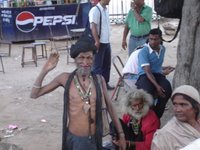 assortment of guns, knives, and swords. My favorite display was an arrangement of weapons that spelled out “Welcome”, with a caption reading “a collection of backscratchers and daggers”. Rajasthani men in red turbans and white suits could be paid to be photographed. We saw a handicrafts emporium (Vijay probably got a huge commission for bringing us), which was extremely overpriced. We had a painter demonstrate his job, which was kept in the family for generations. He told us that he doesn’t make the squirrel-hair brushes himself because as he said, “Have you ever tried to catch a squirrel?”. I swam in the nice pool after returning home. That was short lived, because once it got dark, a horde of bats started swooping over the water at my head. I ate dinner and then headed to the bar on the rooftop, overlooking the city. It was really nice except for the weird pornographic elevator music.
assortment of guns, knives, and swords. My favorite display was an arrangement of weapons that spelled out “Welcome”, with a caption reading “a collection of backscratchers and daggers”. Rajasthani men in red turbans and white suits could be paid to be photographed. We saw a handicrafts emporium (Vijay probably got a huge commission for bringing us), which was extremely overpriced. We had a painter demonstrate his job, which was kept in the family for generations. He told us that he doesn’t make the squirrel-hair brushes himself because as he said, “Have you ever tried to catch a squirrel?”. I swam in the nice pool after returning home. That was short lived, because once it got dark, a horde of bats started swooping over the water at my head. I ate dinner and then headed to the bar on the rooftop, overlooking the city. It was really nice except for the weird pornographic elevator music.
Thursday, August 24 Hellish Classes, Opposites of the US, Dinner at Shrikhandes
Professor Veena Kukreja is just too boring, I’m sorry. Today she told us that
Thursday, August 24, 2006
Wednesday, August 23 Current Events, Awkward Party
 is actually infuriating. I’m sorry, but your track record is a joke. Let’s see, shall we? Bush’s approval rating has slumped to an all-time low (37%), Iraq is still in shambles and civil war, democracy has not been instituted anywhere in the Middle East, 2,600 Americans and 45,000 Iraqi civilians have died thus far, extremists have grown stronger, Iran has developed nuclear capabilities, Israel has created hostile neighbors everywhere around it, anti-American resentment in the Middle East is the highest it has ever been, and oil and gas prices have skyrocketed. And that’s just the
is actually infuriating. I’m sorry, but your track record is a joke. Let’s see, shall we? Bush’s approval rating has slumped to an all-time low (37%), Iraq is still in shambles and civil war, democracy has not been instituted anywhere in the Middle East, 2,600 Americans and 45,000 Iraqi civilians have died thus far, extremists have grown stronger, Iran has developed nuclear capabilities, Israel has created hostile neighbors everywhere around it, anti-American resentment in the Middle East is the highest it has ever been, and oil and gas prices have skyrocketed. And that’s just the  I bought some more jeans (I can actually wear these comfortably in public), and I had to get them tailored. I almost want to get them to tailor acid-wash jeans overalls. Oh, the possibilities are endless! I ate a huge meal at a South Indian restaurant, and then I walked around Palika Bazaar, where I got an mp3 CD with all the Hindi music I could possibly want. I got ready and went out in my denim shirt embroidered with parrots to Mora’s birthday surprise party, of which Ajay ruined the surprise already. It was really awkward; about two people were wasted, Bottle’s friends were there for some reason, it was sweltering, and others (including me) just wanted an excuse to leave, so I offered to walk home the girls (who were getting speakers for a dance party at our house), and I conveniently never came back.
I bought some more jeans (I can actually wear these comfortably in public), and I had to get them tailored. I almost want to get them to tailor acid-wash jeans overalls. Oh, the possibilities are endless! I ate a huge meal at a South Indian restaurant, and then I walked around Palika Bazaar, where I got an mp3 CD with all the Hindi music I could possibly want. I got ready and went out in my denim shirt embroidered with parrots to Mora’s birthday surprise party, of which Ajay ruined the surprise already. It was really awkward; about two people were wasted, Bottle’s friends were there for some reason, it was sweltering, and others (including me) just wanted an excuse to leave, so I offered to walk home the girls (who were getting speakers for a dance party at our house), and I conveniently never came back.
Tuesday, August 22, 2006
Tuesday, August 22 Riding on Bus Tops Through Haryana, Dadi's Family
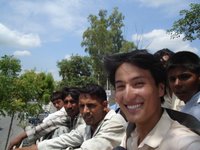 pposed to be the heartland of the state, with rural villagers who only speak Haryanwi, not even Hindi. The ride there was ok, but I couldn’t take pictures because the lighting was bad. I got out at Jind, and started walking to go see some rural life, through the crowded, busy town. I bought four bananas from one of probably 25 banana-vendors. Walking in the 100-degree heat for 15 minutes was unbearable. My shirt was soaked, I was turning into a brown man, and my eyes burned from the dust. Some of the people looked at me funny, especially when I whipped out the camera. I remember watching a 1981 movie in Anthropology Class called Dadi’s Family, about a family of Haryana farmers led
pposed to be the heartland of the state, with rural villagers who only speak Haryanwi, not even Hindi. The ride there was ok, but I couldn’t take pictures because the lighting was bad. I got out at Jind, and started walking to go see some rural life, through the crowded, busy town. I bought four bananas from one of probably 25 banana-vendors. Walking in the 100-degree heat for 15 minutes was unbearable. My shirt was soaked, I was turning into a brown man, and my eyes burned from the dust. Some of the people looked at me funny, especially when I whipped out the camera. I remember watching a 1981 movie in Anthropology Class called Dadi’s Family, about a family of Haryana farmers led by the matriarch Dadi (meaning Mother-In-Law because a woman moves from her natal village to live with her husbands’). Anyways, I am positive I just found Dadi. She looks exactly the same but a little older, and was wearing the exact same outfit. I managed to get a picture of her. After that, I felt like I had accomplished enough for the day, so I turned back in a furious sweat, to the bus station. I saw all these uniformed schoolboys riding on the tops of buses, which looked like fun/extremely dangerous. I talked to one of the students, and a bunch of high-school kids and I jumped on top and rode the bus to Panipat, 60 km away. They all crowded around and wanted to talk to me, see where I was from, what I was doing in Jind, and how much sex I have. I was invited to one of their houses, but I was so exhausted I didn’t have the energy to try and hurdle the language barrier. Most of them got off the bus as we rode further and further to Panipat. On the way, I saw quintessential rura
by the matriarch Dadi (meaning Mother-In-Law because a woman moves from her natal village to live with her husbands’). Anyways, I am positive I just found Dadi. She looks exactly the same but a little older, and was wearing the exact same outfit. I managed to get a picture of her. After that, I felt like I had accomplished enough for the day, so I turned back in a furious sweat, to the bus station. I saw all these uniformed schoolboys riding on the tops of buses, which looked like fun/extremely dangerous. I talked to one of the students, and a bunch of high-school kids and I jumped on top and rode the bus to Panipat, 60 km away. They all crowded around and wanted to talk to me, see where I was from, what I was doing in Jind, and how much sex I have. I was invited to one of their houses, but I was so exhausted I didn’t have the energy to try and hurdle the language barrier. Most of them got off the bus as we rode further and further to Panipat. On the way, I saw quintessential rura l India; men in white kurta and turbans sitting under the shade of trees playing cards and smoking hookah, women carrying huge bundles of wheat and water pails on their heads, families being pulled on carts by water buffalo, endless plains of cultivated rice paddies, wheat fields, and sugar plantations. I passed the Panipat Thermal Energy Plant, a huge nuclear power plant, built right up against slums, rural houses, and rice fields. It was straight out of a movie, the British voice saying, “Planet Earth uses 3000 times as much energy as is being created by nature. Moreover, urbanization and rapid consumption of natural resources threaten global sustainability le
l India; men in white kurta and turbans sitting under the shade of trees playing cards and smoking hookah, women carrying huge bundles of wheat and water pails on their heads, families being pulled on carts by water buffalo, endless plains of cultivated rice paddies, wheat fields, and sugar plantations. I passed the Panipat Thermal Energy Plant, a huge nuclear power plant, built right up against slums, rural houses, and rice fields. It was straight out of a movie, the British voice saying, “Planet Earth uses 3000 times as much energy as is being created by nature. Moreover, urbanization and rapid consumption of natural resources threaten global sustainability le vels for future generations.” Panipat was a busy, dusty, sprawling, boring town, and I just wanted to get back to
vels for future generations.” Panipat was a busy, dusty, sprawling, boring town, and I just wanted to get back to Monday, August 21 Indian Peoples' Questions, India is Crowded
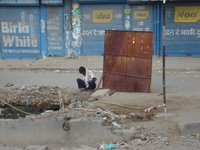 res) are always the same. 1) What is your country?
res) are always the same. 1) What is your country?  your good name? Taylor (a blatant lie, but they end up saying Thailand if I say ‘Tyler’, if you have a weird name and go to Starbucks you know exactly what I mean), 9) You know Texas, I have Aunt there? I have not been
your good name? Taylor (a blatant lie, but they end up saying Thailand if I say ‘Tyler’, if you have a weird name and go to Starbucks you know exactly what I mean), 9) You know Texas, I have Aunt there? I have not been 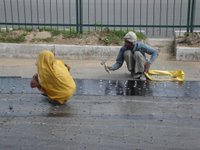 pacity. Privacy and personal space do not exist unless you are willing to pay for it. Every day your senses are bombarded with every aspect of life in
pacity. Privacy and personal space do not exist unless you are willing to pay for it. Every day your senses are bombarded with every aspect of life in Sunday, August 20 Haryana, Cricket, College English Tests, Signage
 the batsman hits it on the bounce. The fielders try and catch it or stop the batsmen from running to the opposite goal. The number of scores before getting out is recorded before the other team bats. It’s complicated and seems like baseball, but not as fun. I had a sudden urge to watch a baseball game, which probably isn’t going to happen. I tried batting the cricket ball, which is hard because it’s an underhand swing and you have to hit it after the bounce. After nearly killing the catcher with a foul ball, I knocked a line drive, almost killing the bowler. They thought it was pretty funny. I sat around while the team members talked in the shade. The coach was Stephan Meloy’s Indian twin. Every shop in Nilokheri seemed to shut its doors on Sunday. Cricket is the favorite Sunday event for the young men, and sitting around playing cards seems to be a favorite with older men. Near the field, a group of Indian electrical engineering students gathered to receive their grades from the small polytechnic college. I was taken inside and shown their computer lab, a small room with typewriters and where they were building computers, which looked really old and slow. Such a juxtaposition; right next to a cricket field, sewage-filled stream, herd of water buffalo, rice and wheat fields, sits a village with an high-tech engineering polytechnic college. They all wanted to practice their English, so I used my normal accent. In order to study in the English-speaking world, everyone has to pass a test, called the International English Language Testing System, from the
the batsman hits it on the bounce. The fielders try and catch it or stop the batsmen from running to the opposite goal. The number of scores before getting out is recorded before the other team bats. It’s complicated and seems like baseball, but not as fun. I had a sudden urge to watch a baseball game, which probably isn’t going to happen. I tried batting the cricket ball, which is hard because it’s an underhand swing and you have to hit it after the bounce. After nearly killing the catcher with a foul ball, I knocked a line drive, almost killing the bowler. They thought it was pretty funny. I sat around while the team members talked in the shade. The coach was Stephan Meloy’s Indian twin. Every shop in Nilokheri seemed to shut its doors on Sunday. Cricket is the favorite Sunday event for the young men, and sitting around playing cards seems to be a favorite with older men. Near the field, a group of Indian electrical engineering students gathered to receive their grades from the small polytechnic college. I was taken inside and shown their computer lab, a small room with typewriters and where they were building computers, which looked really old and slow. Such a juxtaposition; right next to a cricket field, sewage-filled stream, herd of water buffalo, rice and wheat fields, sits a village with an high-tech engineering polytechnic college. They all wanted to practice their English, so I used my normal accent. In order to study in the English-speaking world, everyone has to pass a test, called the International English Language Testing System, from the  ed it down to ‘fall’ or ‘decline’) in oil prices created a need for alternate energy sources. Are you kidding! It’s supposed to test academic, conversational, and everyday English. If a native educated English-speaker cannot determine the answer, I think that’s a little unfair. Inside the test booklet was one of their resumes to study in the West, and it was horrible. I helped him organize his resume to make it more presentable. He had put the personal information (like Father’s name and occupation which is required in
ed it down to ‘fall’ or ‘decline’) in oil prices created a need for alternate energy sources. Are you kidding! It’s supposed to test academic, conversational, and everyday English. If a native educated English-speaker cannot determine the answer, I think that’s a little unfair. Inside the test booklet was one of their resumes to study in the West, and it was horrible. I helped him organize his resume to make it more presentable. He had put the personal information (like Father’s name and occupation which is required in  i was getting on my nerves. He was very hospitable, but he acted like he owned the town, which is unfortunately literally true, him being a landlord. He acted like a tough guy, and as if he was really popular and a pimp. It was annoying, plus the town was getting kind of boring; all I do is sit, repeat conversations, and eat. Shashi dropped me off at the bus station, where I flagged down a bus within two minutes, to
i was getting on my nerves. He was very hospitable, but he acted like he owned the town, which is unfortunately literally true, him being a landlord. He acted like a tough guy, and as if he was really popular and a pimp. It was annoying, plus the town was getting kind of boring; all I do is sit, repeat conversations, and eat. Shashi dropped me off at the bus station, where I flagged down a bus within two minutes, to Saturday, August 19 Wandering Haryana, Nilokheri, Indian Hospitality
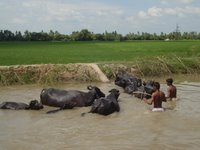 s’) started talking to me. He told me a lot about
s’) started talking to me. He told me a lot about 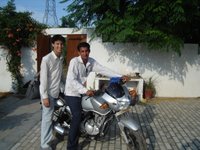 oes not exist at all in the
oes not exist at all in the  upscale shopping center. Along the Golden Quadrilateral, there are a lot of these brand-new bourgeois rest stations. We ate Tikka Aloo burgers at the AC McDonalds (which had a drive-thru for foot traffic only). After McDonalds we drove to the sports complex, where people were playing cricket, boxing (Indians love watching American wrestling, Titanic, and Brad Pitt movies for some reason), playing soccer, and running. We waited for men’s swim time, after the ladies’. There was an extremely unappealing advertisement for the pool, which had women fully-dressed in saris covering their faces and entire bodies, while men were dripping wet in tighty-whiteys and Speedos. That would suck all the fun out of lifeguarding (but the fact that you sit in a chair and get paid over $10 an hour makes up for it). I told them I was a lifeguard in
upscale shopping center. Along the Golden Quadrilateral, there are a lot of these brand-new bourgeois rest stations. We ate Tikka Aloo burgers at the AC McDonalds (which had a drive-thru for foot traffic only). After McDonalds we drove to the sports complex, where people were playing cricket, boxing (Indians love watching American wrestling, Titanic, and Brad Pitt movies for some reason), playing soccer, and running. We waited for men’s swim time, after the ladies’. There was an extremely unappealing advertisement for the pool, which had women fully-dressed in saris covering their faces and entire bodies, while men were dripping wet in tighty-whiteys and Speedos. That would suck all the fun out of lifeguarding (but the fact that you sit in a chair and get paid over $10 an hour makes up for it). I told them I was a lifeguard in  mins or Punjabis, and male. They all asked the same questions, so I had to repeat the same information fifteen times. I asked what they did on a normal basis. They said they like taking it easy and just relaxing, something Indians enjoy, but which I don’t like doing too much of. They said they like going on the computer, watching TV, and going to college. There aren’t many clubs or parties to attend, and many are pure-veg, so they cannot drink. Sounds like American college students…the kind who go to Harvard or Whitman. We finally got back to Shashi’s house after the small-talk that would never end. His mom had cooked us a delicious feast, which included a potato/pea/cauliflower curry, buttered roti, wheat pudding, and dhee curd that made an amazing contrast to relieve the palate of the spicy masala. When we ran out of food, he yelled at his mom in the other room to bring more. It was straight out of Wedding Crashers. “Maa, roti”, “Maa, sabzi”, “Maa, dhee”. She was really nice, and loved feeding us. I ate a lot, and was cautious, but he wanted me to eat as much as I wanted to. He even bought my water and paid for my McDonalds, because I am his guest. I feel awkward when people do that; I’d rather pay myself. Shashi, his mother, and I all shared a bed that night. I got bit by mosquitoes because Americans have more sugar in their diet, which attracts mosquitoes, that don’t ever bother Indians.
mins or Punjabis, and male. They all asked the same questions, so I had to repeat the same information fifteen times. I asked what they did on a normal basis. They said they like taking it easy and just relaxing, something Indians enjoy, but which I don’t like doing too much of. They said they like going on the computer, watching TV, and going to college. There aren’t many clubs or parties to attend, and many are pure-veg, so they cannot drink. Sounds like American college students…the kind who go to Harvard or Whitman. We finally got back to Shashi’s house after the small-talk that would never end. His mom had cooked us a delicious feast, which included a potato/pea/cauliflower curry, buttered roti, wheat pudding, and dhee curd that made an amazing contrast to relieve the palate of the spicy masala. When we ran out of food, he yelled at his mom in the other room to bring more. It was straight out of Wedding Crashers. “Maa, roti”, “Maa, sabzi”, “Maa, dhee”. She was really nice, and loved feeding us. I ate a lot, and was cautious, but he wanted me to eat as much as I wanted to. He even bought my water and paid for my McDonalds, because I am his guest. I feel awkward when people do that; I’d rather pay myself. Shashi, his mother, and I all shared a bed that night. I got bit by mosquitoes because Americans have more sugar in their diet, which attracts mosquitoes, that don’t ever bother Indians.
Monday, August 21, 2006
Friday, August 18 My pathetic Hindi
 was two hours late. Nevertheless, we had class. Puran left, so Nikhil and I are the only people left in our house right now. We had dinner with Amber and Tahara at a South Indian restaurant in
was two hours late. Nevertheless, we had class. Puran left, so Nikhil and I are the only people left in our house right now. We had dinner with Amber and Tahara at a South Indian restaurant in Thursday, August 17 Class, Egyptian Eye Shadow, Crazy Metro Riders

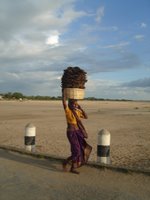 I went to bed alone, and when I woke up I found Nikhil lying in the bed next to mine. Whoa! I had boring class early, and luckily I can take State and Society in South Asia instead of the class on
I went to bed alone, and when I woke up I found Nikhil lying in the bed next to mine. Whoa! I had boring class early, and luckily I can take State and Society in South Asia instead of the class on  I finally discovered what it was that babies were wearing on their eyes. What I thought was black eye shadow painted on like an Egyptian was actually medicine for eye infections that are put on young children. One thing I have noticed while riding the Metro; people are crazy. Whenever a train approaches at the station, people run and crowd around the door, thus creating an impenetrable wall of people. There is a beep, and the doors start sliding open, and everyone is pushed inside by the crowd. Once inside, there are always these little men who run to get the open seat. And it’s the same when people are getting off at a station; the same guys look for someone grabbing their belongings to leave, and they jump to th
I finally discovered what it was that babies were wearing on their eyes. What I thought was black eye shadow painted on like an Egyptian was actually medicine for eye infections that are put on young children. One thing I have noticed while riding the Metro; people are crazy. Whenever a train approaches at the station, people run and crowd around the door, thus creating an impenetrable wall of people. There is a beep, and the doors start sliding open, and everyone is pushed inside by the crowd. Once inside, there are always these little men who run to get the open seat. And it’s the same when people are getting off at a station; the same guys look for someone grabbing their belongings to leave, and they jump to th e open seat like gophers to their holes. I don’t even try anymore, I can’t compete with that. The three or four people who try and get out are as hopeless as a blind man driving. Then, once everyone is inside, the doors will stay open another 10 seconds with no one moving. But then there are always the stragglers running to hop onto the train at the last second. On one such occasion, a mom and baby were hit and sandwiched by the closing doors. It’s the one thing in
e open seat like gophers to their holes. I don’t even try anymore, I can’t compete with that. The three or four people who try and get out are as hopeless as a blind man driving. Then, once everyone is inside, the doors will stay open another 10 seconds with no one moving. But then there are always the stragglers running to hop onto the train at the last second. On one such occasion, a mom and baby were hit and sandwiched by the closing doors. It’s the one thing in Wednesday, August 16 Krishna's Birthday, Post-Independence Day

Once I got off the AC train at New Delhi Station, a blast of fiery hot air hit me. Welcome back to hell. I awkwardly walked all the way over the bridge to the Metro station and was going through the security with three bags and a water bottle
 filled with
filled with  0 degrees outside, and 2) security for the Metro was so tight that I had to wait in a 10-minute line to get padded down. After exiting the Metro station at Civil Lines, I saw a man riding an elephant down the street, just lumbering along, no big deal. I headed over to Rajpath and as I expected, it had a carnival, fair type feeling because it was a holiday for
0 degrees outside, and 2) security for the Metro was so tight that I had to wait in a 10-minute line to get padded down. After exiting the Metro station at Civil Lines, I saw a man riding an elephant down the street, just lumbering along, no big deal. I headed over to Rajpath and as I expected, it had a carnival, fair type feeling because it was a holiday for  I went to dinner with Puran and Tahara, who is visiting from
I went to dinner with Puran and Tahara, who is visiting from Tuesday, August 15 Indian Independence Day, Bodhgaya
 I reached
I reached  ll and listened to a speech by the mayor in Hindi, which I obviously didn’t understand. He raised the cotton flag on the pole, which at its base was showered in flower petals and had an
ll and listened to a speech by the mayor in Hindi, which I obviously didn’t understand. He raised the cotton flag on the pole, which at its base was showered in flower petals and had an 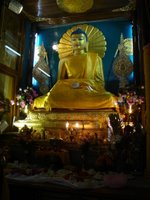 s were loud and took pictures. Monks from around the world all came to the temple to visit and meditate at the holy site. After seeing the temple, I walked down the road, shopping for little wooden Buddha carvings (which I bought for 50 Rs each). There was an abandoned Hindu temple, vines and tree trunks engulfing the rotting stone buildings. Countries with large Buddhist populations all have buildings to represent themselves here, much like
s were loud and took pictures. Monks from around the world all came to the temple to visit and meditate at the holy site. After seeing the temple, I walked down the road, shopping for little wooden Buddha carvings (which I bought for 50 Rs each). There was an abandoned Hindu temple, vines and tree trunks engulfing the rotting stone buildings. Countries with large Buddhist populations all have buildings to represent themselves here, much like 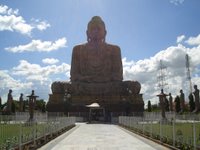 ut his son is studying in
ut his son is studying in  flipped and then taken off the pan, and put directly over the flame, where they puff up, after which they are put in the serving plate. Breakfasts in the household consist of rice and dal, and dinners always include vegetables and chapatis. This is because these are light foods, unlike puri, which can give you gas. I stayed over at his house late into the night until I had to catch my train. I took a shared rickshaw with Japanese tourists, who constitute 95% of Vijay’s hotel business. Today was a really good day, I seeing Independence Day celebrations, the sacred Bodhi Tree, and being the guest for an Indian family’s dinner. I caught the high-speed electrified Rajdhani Express, but the wrong one, so I had to run and jump off as the train was moving. Despite the high-speed factor and the nice sheets and free breakfast, it still took 12 hours to get back to
flipped and then taken off the pan, and put directly over the flame, where they puff up, after which they are put in the serving plate. Breakfasts in the household consist of rice and dal, and dinners always include vegetables and chapatis. This is because these are light foods, unlike puri, which can give you gas. I stayed over at his house late into the night until I had to catch my train. I took a shared rickshaw with Japanese tourists, who constitute 95% of Vijay’s hotel business. Today was a really good day, I seeing Independence Day celebrations, the sacred Bodhi Tree, and being the guest for an Indian family’s dinner. I caught the high-speed electrified Rajdhani Express, but the wrong one, so I had to run and jump off as the train was moving. Despite the high-speed factor and the nice sheets and free breakfast, it still took 12 hours to get back to